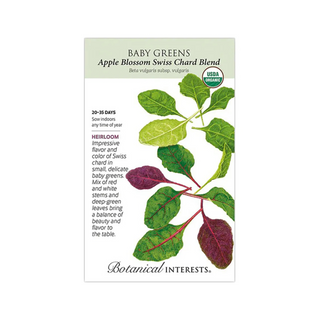
Description
Young leaves are great in salads, steamed, stir-fried, added to lasagna, omelets, soups and stews and mixed with other greens. Apple Blossom Swiss Chard baby greens can be grown indoors at any time of year and are a nutrient-packed way to get your "green fix" in the dead of winter. Move containers as needed for best light exposure and temperature. Harvest when 2"-4" tall and enjoy!
Variety Info
- Days to Maturity: 20–35 days
- Family: Amaranthaceae
- Type: Baby Greens
- Native: Mediterranean region, Europe
- Hardiness: Biennial; fairly cold tolerant. Will overwinter in mild climates and withstand light to moderate freezes.
- Exposure: Full sun
- Plant Dimensions: Harvest at 2"-4" tall
- Variety Info: As a baby green, small leaves with wide, fan-like, savoyed (crinkled) green leaves. Mix of white and red stems.
- Attributes: Frost Tolerant, Cold Tolerant, Good For Containers
Sowing Info
- When to Sow Outside: 2 to 4 weeks before your average last frost date, when soil temperature is at least 40°F, ideally 75°–90°F. Sow as late as 2 months before first fall frost. Mild climates: Sow in fall.
- When to Start Inside: RECOMMENDED. Sow indoors any time of year, with indoor temperatures 60°–75°F. Successive Sowings: Every 2 weeks for a continual supply.
- Days to Emerge: 5–10 days
- Seed Depth: ½"
- Seed Spacing: 3/4"
- Thinning: Not required.
Growing Info
- Harvesting: When seedlings emerge, the first pair of leaves to show are the cotyledons, which can look very different from the leaves that follow, called "true" leaves. Baby greens are ready to harvest when they have true leaves, at 2"–4". Slow growers, or cool growing temperatures may require more time. Harvest by cutting just above the soil line. For more than one harvest (up to 3 before flavor declines) leave about 1/2" of leafy growth on the small plants so they can regenerate.
Description
Young leaves are great in salads, steamed, stir-fried, added to lasagna, omelets, soups and stews and mixed with other greens. Apple Blossom Swiss Chard baby greens can be grown indoors at any time of year and are a nutrient-packed way to get your "green fix" in the dead of winter. Move containers as needed for best light exposure and temperature. Harvest when 2"-4" tall and enjoy!
Variety Info
- Days to Maturity: 20–35 days
- Family: Amaranthaceae
- Type: Baby Greens
- Native: Mediterranean region, Europe
- Hardiness: Biennial; fairly cold tolerant. Will overwinter in mild climates and withstand light to moderate freezes.
- Exposure: Full sun
- Plant Dimensions: Harvest at 2"-4" tall
- Variety Info: As a baby green, small leaves with wide, fan-like, savoyed (crinkled) green leaves. Mix of white and red stems.
- Attributes: Frost Tolerant, Cold Tolerant, Good For Containers
Sowing Info
- When to Sow Outside: 2 to 4 weeks before your average last frost date, when soil temperature is at least 40°F, ideally 75°–90°F. Sow as late as 2 months before first fall frost. Mild climates: Sow in fall.
- When to Start Inside: RECOMMENDED. Sow indoors any time of year, with indoor temperatures 60°–75°F. Successive Sowings: Every 2 weeks for a continual supply.
- Days to Emerge: 5–10 days
- Seed Depth: ½"
- Seed Spacing: 3/4"
- Thinning: Not required.
Growing Info
- Harvesting: When seedlings emerge, the first pair of leaves to show are the cotyledons, which can look very different from the leaves that follow, called "true" leaves. Baby greens are ready to harvest when they have true leaves, at 2"–4". Slow growers, or cool growing temperatures may require more time. Harvest by cutting just above the soil line. For more than one harvest (up to 3 before flavor declines) leave about 1/2" of leafy growth on the small plants so they can regenerate.

